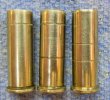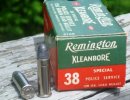You are using an out of date browser. It may not display this or other websites correctly.
You should upgrade or use an alternative browser.
You should upgrade or use an alternative browser.
Explain the difference and use of these 3 38 Spec R-P cases
- Thread starter JWFilips
- Start date
RicinYakima
High Steppes of Eastern Washington
The one on the right is a wadcutter case, thin walled down to bottom mark. Middle is lead bullet for standard velocity load. Left is jacketed bullet load with thicker side walls.
At least that is what I have been told in the past. What are the head stamps?
At least that is what I have been told in the past. What are the head stamps?
RicinYakima
High Steppes of Eastern Washington
Wadcutters are seated full depth to feed in Colt 1911's and Smith 52's. Historically, the case walls got thicker below where a 158 grain round nose bullet was seated. If you have any 1930's 38/44 cases you can measure the wall thickness below the bullet.So it has to do with case wall thickness?
What happens is that a full length resized thick case squeezes down the bottom of the wad cutter when seated, decreasing accuracy. The work around is to use a HB wadcutter.
fiver
Well-Known Member
they do make wadcutter brass that's thin and straight almost all the way to the bottom.
the canellures are just where the base of the bullet would sit. [probably some 125gr. metal wrapped stuff on the left case]
funny thing is they don't always do it, and different makers [factory] do it at different times.
i pretty much throw it all together unless i know for certain that it's the wad cutter stuff then i keep that separate.
if i don't want to take the time to measure out the suspect cases it all goes in the bucket.
the canellures are just where the base of the bullet would sit. [probably some 125gr. metal wrapped stuff on the left case]
funny thing is they don't always do it, and different makers [factory] do it at different times.
i pretty much throw it all together unless i know for certain that it's the wad cutter stuff then i keep that separate.
if i don't want to take the time to measure out the suspect cases it all goes in the bucket.
CZ93X62
Official forum enigma
I don't understand the variations of cannelures on 38 Special brass. You can feel them as they pass through a T/C sizer die's ring, though. Most of my decrepit multi-make 38 Special brass has been scrapped now, and Starline has replaced it.
I am not fond of nickeled brass or cannelures.
I am not fond of nickeled brass or cannelures.
That's 2 of us ! !I am not fond of nickeled brass or cannelures.
RicinYakima
High Steppes of Eastern Washington
In the old days, you carried your extra rounds in leather loops on your belt. Brass cases would corrode from the leather and turn green. Sometimes they would not fit into the cylinder.What's the purpose of nickel plating brass?
I was given a whole bucket of nickeled brass off a law enforcement range. Been using it for years. The plating flakes off occasionally. No other problems tho. But no advantages either that I can tell.
Bret4207
At the casting bench in the sky. RIP Bret.
Nickel kept the brass from corroding. Wasn't all that long ago that corrosives in primers or powder would sort of crystalize the brass. The nickel, inside and out, prevented that. In later times I suppose nickel was more "bling". All the 357 and 38 ammo we carried in loop loaders was always nickle so it didn't clash with our silver/chromed/stainless/nickeled uniform snaps, belt buckles, etc. And yet, our shield was brass and was never worn on the uniform! Huh, never thought about that before.
Bret4207
At the casting bench in the sky. RIP Bret.
I've had old canneluered brass crack at the line a bunch of times. Even had them break off in the sizing die. Now that I think on it, I have no idea how old that stuff was and wonder if maybe it had been shot back when the corrosive primers/powder were in use. I know from reading old articles from the 30's and 40's that they were still around into that period and considering that the brass I got could easily have been that old, that may have been the cause.
I've had nickle plating separate from the brass, but that brass was pretty well worn out by the time that happened. Never had any damage to dies I'm aware of.
Am I the only guy that would try and "save" cracked cases by trimming 15 or 20 in a group to a shorter length, far shorter than the listed minimum, and use it for light loads? Yes, I am/was that cheap!!!
I've had nickle plating separate from the brass, but that brass was pretty well worn out by the time that happened. Never had any damage to dies I'm aware of.
Am I the only guy that would try and "save" cracked cases by trimming 15 or 20 in a group to a shorter length, far shorter than the listed minimum, and use it for light loads? Yes, I am/was that cheap!!!
Last edited:
Rick H
Well-Known Member
I have reloaded nickel plate and brass 38 cases for near 50 years. Hard to tell which lasts longer. I toss split cases when I find them. I seem to find bad ones of all types. I don't sort 38 cases and I don't load them up to get the last bit of velocity either. When I carry a 38 it is mostly with factory ammo. My reloaded stuff is for practice and playing with.
Petrol & Powder
Well-Known Member
Ditto..............
I am not fond of nickeled brass or cannelures.
I use nickel plated casings to differentiate loadings when I cannot use the type of bullet to tell them apart. For example, full charge wadcutters get loaded into nickel casings to make the cartridge visibly distinct from target wadcutters using the same bullet.
When the mouth of those nickel casings split (and they seem to split with fewer loading cycles than brass casings) I happily discard them.
RBHarter
West Central AR
I don't know. Seems like there's all sorts of data from 38 Short and 9×17 with stops every couple of mm all the way to 357 and most of the data overlaps or picks up/drops off where the one above or below starts or ends . 9×23 Rimmed shoots very well in a security 6 357 ....... it wasn't bad in the 1894 Marlin that would take 13+1 instead of 10 .I've had old canneluered brass crack at the line a bunch of times. Even had them break off in the sizing die. Now that I think on it, I have no idea how old that stuff was and wonder if maybe it had been shot back when the corrosive primers/powder were in use. I know from reading old articles from the 30's and 40's that they were still around into that period and considering that the brass I got could easily have been that old, that may have been the cause.
I've had nickle plating separate from the brass, but that brass was pretty well worn out by the time that happened. Never had any damage to dies I'm aware of.
Am I the only guy that would try and "save" cracked cases by trimming 15 or 20 in a group to a shorter length, far shorter than the listed minimum, and use it for light loads? Yes, I am/was that cheap!!!


